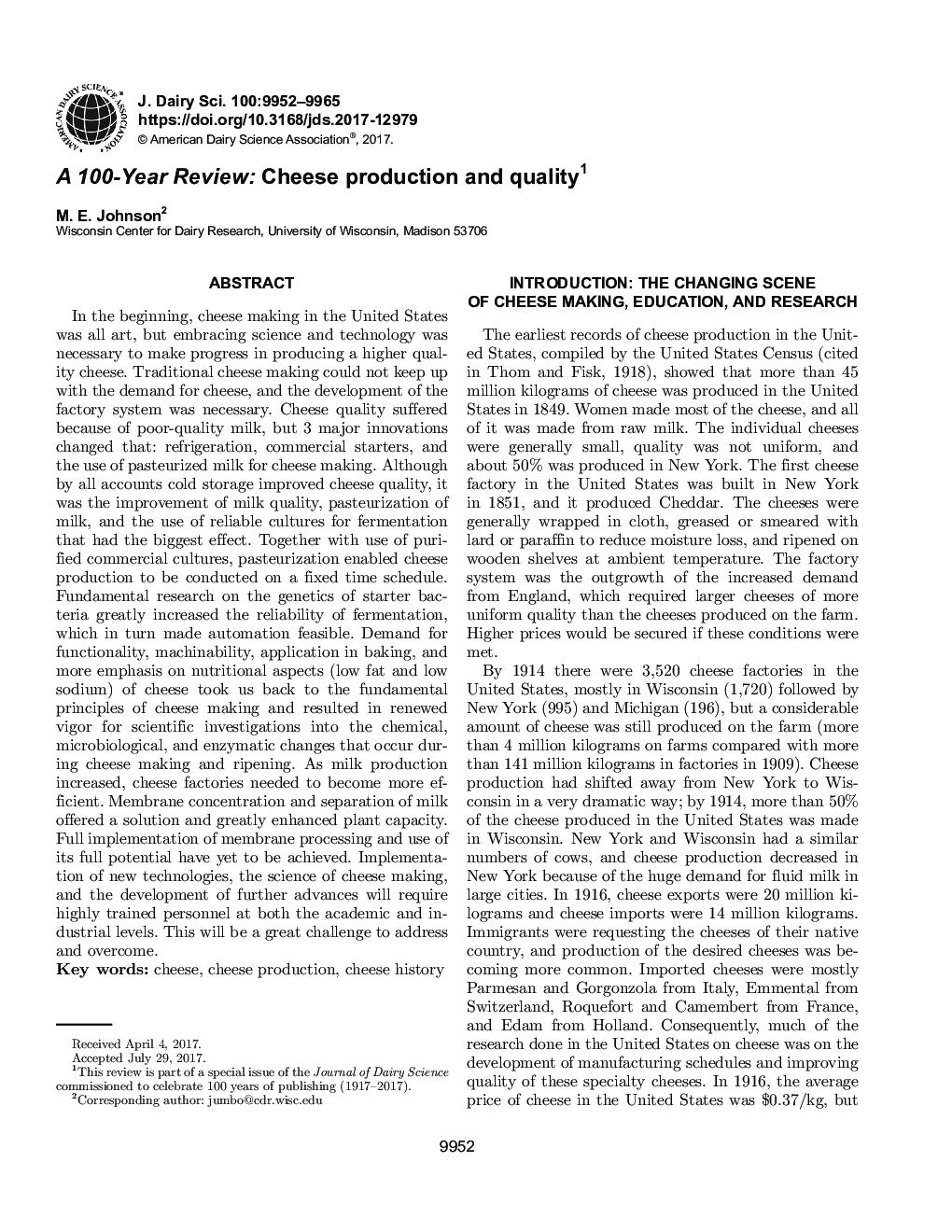| کد مقاله | کد نشریه | سال انتشار | مقاله انگلیسی | نسخه تمام متن |
|---|---|---|---|---|
| 8501749 | 1553845 | 2017 | 14 صفحه PDF | دانلود رایگان |
عنوان انگلیسی مقاله ISI
A 100-Year Review: Cheese production and quality
ترجمه فارسی عنوان
بررسی 100 ساله: تولید و کیفیت پنیر
دانلود مقاله + سفارش ترجمه
دانلود مقاله ISI انگلیسی
رایگان برای ایرانیان
کلمات کلیدی
پنیر، تولید پنیر، تاریخچه پنیر،
ترجمه چکیده
در ابتدا، ساخت پنیر در ایالات متحده همه هنر بود، اما درک علم و فن آوری برای پیشرفت در تولید پنیر با کیفیت بالاتر ضروری بود. ساخت پنیر سنتی نمیتواند تقاضای پنیر را حفظ کند و توسعه سیستم کارخانه ضروری بود. کیفیت پنیر به علت شیر با کیفیت پایین رنج می برد، اما 3 نوآوری عمده تغییر یافتند: یخچال، پایه های تجاری و استفاده از شیر پاستوریزه برای ساخت پنیر. اگر چه با توجه به همه موارد، ذخیره سازی سرد باعث بهبود کیفیت پنیر شد، بهبود کیفیت شیر، پاستوریزاسیون شیر و استفاده از فرهنگ قابل اعتماد برای تخمیر بود که بیشترین تأثیر را داشت. با استفاده از فرهنگ های تجاری تصفیه شده، پاستوریزاسیون امکان تولید پنیر را در یک برنامه زمانی مشخص فراهم می کند. تحقیقات بنیادی در مورد ژنتیک باکتری های استارت، قابلیت اطمینان تخمیر را به میزان قابل توجهی افزایش داده است که به نوبه خود اتوماسیون را امکان پذیر ساخته است. تقاضا برای عملکرد، ماشینکاری، کاربرد در پخت، و تأکید بیشتر بر جنبه های تغذیه ای (کم چربی و کم سدیم) پنیر ما را به اصول اساسی تولید پنیر بازگردانید و موجب شد تا قدرت تحقیقات علمی شیمیایی، میکروبیولوژی و تغییرات آنزیمی که در طول پنیر ساخت و رسیدن رخ می دهد. با افزایش تولید شیر، کارخانجات پنیر نیاز به کارآیی بیشتری دارند. غلظت غشاء و جداسازی شیر یک راه حل و ظرفیت گیاه را به میزان قابل توجهی افزایش داد. اجرای کامل پردازش غشاء و استفاده از پتانسیل کامل آن هنوز به دست نیامده است. پیاده سازی فن آوری های جدید، علم ساخت پنیر و توسعه پیشرفت های بیشتر، نیاز به پرسنل بسیار آموزش دیده در سطوح علمی و صنعتی خواهد داشت. این یک چالش بزرگ برای رسیدگی و غلبه بر آن خواهد بود.
موضوعات مرتبط
علوم زیستی و بیوفناوری
علوم کشاورزی و بیولوژیک
علوم دامی و جانورشناسی
چکیده انگلیسی
In the beginning, cheese making in the United States was all art, but embracing science and technology was necessary to make progress in producing a higher quality cheese. Traditional cheese making could not keep up with the demand for cheese, and the development of the factory system was necessary. Cheese quality suffered because of poor-quality milk, but 3 major innovations changed that: refrigeration, commercial starters, and the use of pasteurized milk for cheese making. Although by all accounts cold storage improved cheese quality, it was the improvement of milk quality, pasteurization of milk, and the use of reliable cultures for fermentation that had the biggest effect. Together with use of purified commercial cultures, pasteurization enabled cheese production to be conducted on a fixed time schedule. Fundamental research on the genetics of starter bacteria greatly increased the reliability of fermentation, which in turn made automation feasible. Demand for functionality, machinability, application in baking, and more emphasis on nutritional aspects (low fat and low sodium) of cheese took us back to the fundamental principles of cheese making and resulted in renewed vigor for scientific investigations into the chemical, microbiological, and enzymatic changes that occur during cheese making and ripening. As milk production increased, cheese factories needed to become more efficient. Membrane concentration and separation of milk offered a solution and greatly enhanced plant capacity. Full implementation of membrane processing and use of its full potential have yet to be achieved. Implementation of new technologies, the science of cheese making, and the development of further advances will require highly trained personnel at both the academic and industrial levels. This will be a great challenge to address and overcome.
ناشر
Database: Elsevier - ScienceDirect (ساینس دایرکت)
Journal: Journal of Dairy Science - Volume 100, Issue 12, December 2017, Pages 9952-9965
Journal: Journal of Dairy Science - Volume 100, Issue 12, December 2017, Pages 9952-9965
نویسندگان
M.E. Johnson,
